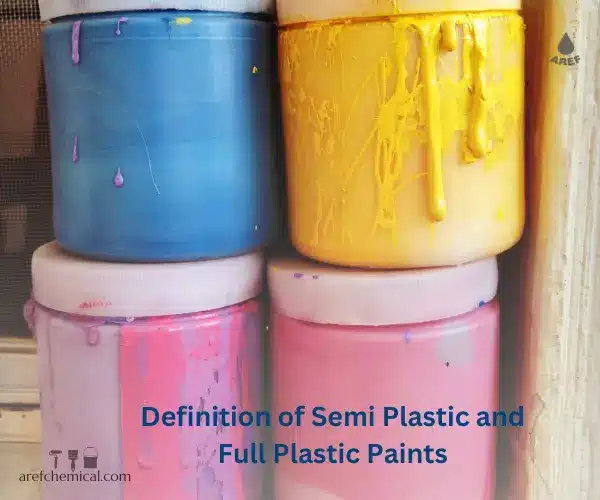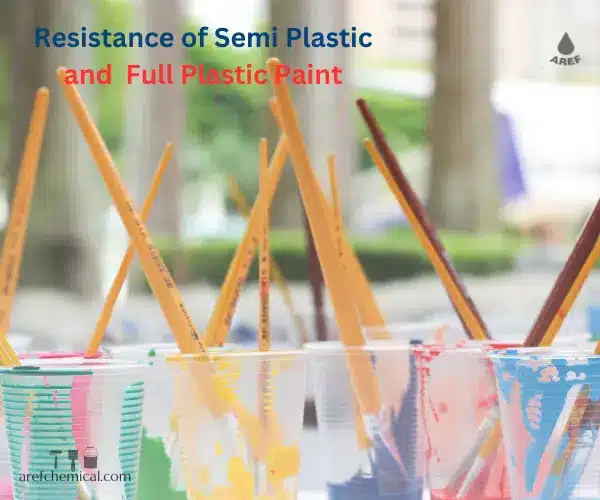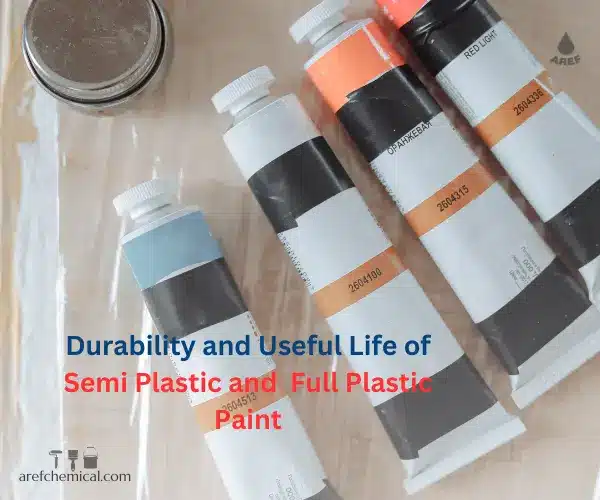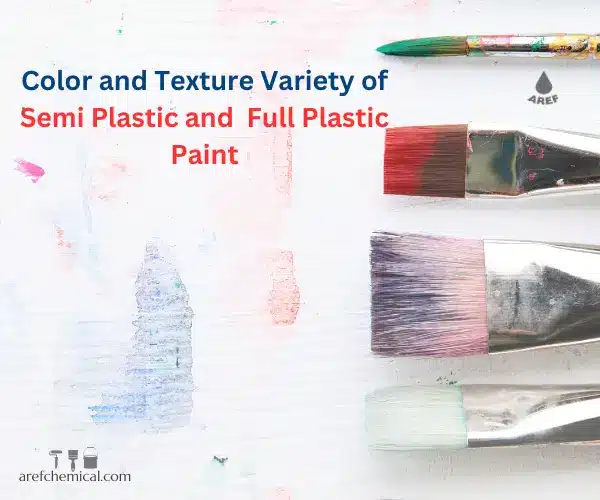The difference between semi plastic and full plastic paint has always been a question for buyers of this product. Because choosing the right paint for interior and exterior painting projects can have a significant impact on the durability, beauty, and protection of surfaces. Among the various options available on the market, Aref semi plastic and full plastic paint are popular choices due to their unique characteristics. This article will examine the basic differences between these two types of paint to help you choose the right paint for your specific needs.
Definition of Semi Plastic and Full Plastic Paints
Semi plastic and full plastic paints are two common types of paints used in building painting. Each of these two types has unique properties that make them suitable for different conditions and applications.
Semi plastic paint:
This type of paint contains a smaller amount of plastic resin, which gives it flexibility and adhesion. Semi-plastic paint is more permeable than full plastic and usually has less covering power, but can still create a uniform and beautiful surface. This type of paint is usually suitable for interior walls that are not exposed to high humidity and abrasion. Due to its semi-breathable nature, it allows moisture to pass through the wall to a limited extent, which can be useful in preventing moisture accumulation.
Full plastic paint:
All-plastic paint, sometimes known as acrylic paint or plastic paint, contains a higher amount of plastic resin, which makes it much more resistant to environmental factors such as moisture, temperature changes and abrasion. This type of paint often produces a thicker and stronger coating and has very high hiding power. All-plastic paint is an ideal choice for environments that are subject to frequent washing and cleaning, such as kitchens and bathrooms. It is also used for painting the exterior of buildings due to its high resistance to various weather conditions. Both types of paint have a wide variety of colors and can be available in matte, semi-gloss and gloss. The choice between these two types should be made according to the needs of the project and the environment in which it is to be used.
Chemical Composition and Physical Properties
The chemical composition and physical properties of semi plastic and full plastic paints can vary, but here is a general overview of both:
Chemical Composition:
- Semi plastic paints:
– Resins: May contain acrylic or vinyl acrylic resins, used in smaller amounts than full-plastic.
– Pigments: Provides color and coverage; may include titanium oxide (TiO2) for whiteness and other pigments for various colors.
– Additives: May include anti-mold agents, agents to improve flow and spreadability, and agents to regulate drying time.
- Full-plastic paints:
– Resins: Usually contain high-quality acrylic or vinyl acrylic resins in larger amounts than semi-plastics, providing greater resistance to environmental factors.
– Pigments: Same as semi-plastics, but may be in higher concentrations to provide better coverage.
– Additives: May include materials to increase resistance to moisture, mold, and mildew, as well as materials to improve the physical properties of the paint.
Physical properties:
- Semi-plastic paint:
– Permeability: Allows the wall to breathe to some extent.
– Flexibility: Less than full plastic.
– Moisture resistance: Less than full plastic.
– Coverage: Usually less than full plastic.
- Full plastic paint:
– Permeability: Less than half plastic; creates a protective barrier against moisture and contamination.
– Flexibility: Higher than half plastic and has good resistance to cracking.
– Moisture resistance: Very high, suitable for use in humid environments.
– Coverage: High, with the ability to hide surface defects well.
Given these differences, the appropriate type of paint should be selected by taking into account the environmental conditions and specific needs of the project. Also, safety and health when working with chemicals should always be considered, and the use of personal protective equipment (PPE) is recommended.
Comparison of Coverage and Hiding Power
Coverage refers to the amount of surface area that a paint or topcoat can effectively cover, while hiding power refers to the ability of the paint to cover underlying colors or imperfections in the surface. Full-plastic topcoats typically have higher coverage and hiding power due to their higher pigment density and higher quality resins than semi-plastic topcoats. This allows them to better cover imperfections and underlying colors with fewer coats.
Resistance of semi plastic and full plastic coatings to different environmental conditions
Semi plastic and full plastic coatings show different resistance to environmental conditions due to their different compositions:
Semi-plastic coatings:
– They are usually less expensive and are recommended for indoor use.
– They are less resistant to moisture and fungus.
– They are less resistant to washing and are better used in low-traffic environments.
– They may be slightly more sensitive to extreme temperature changes and direct sunlight.
– Full-plastic coatings:
– They are suitable for indoor and outdoor use, as they are more resistant to environmental conditions.
– They offer greater resistance to moisture, fungus, and mold.
– Due to their high-quality pigments and resins, they have good resistance to UV radiation and temperature changes.
– They are usually washable and can withstand cleaning stains and dirt.
– Full plastic coatings usually have a longer lifespan and are more resistant to abrasion and scratches. In general, full plastic coatings are recommended for environments exposed to harsher conditions due to their stronger compounds and higher resistance to environmental factors. While semi plastic coatings can be suitable for interior environments with lower traffic and less stringent environmental conditions.
Durability and useful life
The durability and useful life of semi plastic and full plastic coatings can vary greatly and depends on several factors, including the quality of the product, the environmental conditions in which it is used, and how it is applied and maintained. Under normal and standard conditions:
Semi-plastic coating:
– This type of coating is usually less durable and may have a useful life of between 3 and 5 years in indoor conditions.
– In environments with high humidity or high traffic, its useful life may be reduced.
Full-plastic coating:
– Full-plastic coatings are usually longer lasting and can last between 5 and 10 years or more, depending on the quality and type of use.
– This type of coating is more resistant to washing, moisture, and temperature changes, which contributes to its longevity.
It should be noted that the quality of the substrate and surface preparation before applying the coating also has a significant impact on its durability and useful life. Surfaces that are properly cleaned, smoothed, and prepared allow paint to perform at its best. Regular maintenance can also help extend the life of paint.
Maintenance and Cleaning
Semi plastic and full plastic paints are both types of water-based acrylic paints used for interior walls of buildings. The main differences between these two types of paints are in their gloss level, resistance to washing and maintenance.
Maintenance:
– Semi-plastic paint: This type of paint is usually more opaque and has less resistance to washing due to having less plastic coating. It is easier to maintain than full-plastic paint, but you should not expect high resistance to stains and dirt.
– Full-plastic paint: This type of paint has higher resistance to washing and stains due to having a higher amount of resin and plastic. Maintaining this type of paint may be a little more difficult, because stains and dirt settle on a shinier and smoother surface that requires more careful cleaning.
Cleaning:
– Semi-plastic paint: To clean surfaces painted with semi-plastic paint, it is usually recommended to use mild detergents and a soft sponge or cloth. Vigorous washing and the use of harsh detergents may damage the paint coating.
– Full-plastic paint: This type of paint is usually washable and stronger detergent solutions and medium-textured sponges can be used to clean stains. Full-plastic paint is usually more tolerant of abrasion and frequent cleaning.
In any case, for both types of paint, it is best to test cleaning methods and materials on a less visible area of the wall before starting to clean to ensure that the coating is not damaged. It is also always recommended to follow the paint manufacturer’s instructions for maintenance and cleaning.
Indoor and outdoor use
Semi plastic and full plastic coatings are usually designed for indoor spaces, and each has its own characteristics, based on which a more suitable application can be considered for them:
Semi-plastic coating:
– Indoor use: This type of coating is more suitable for surfaces that require less light reflection due to its matte and less glossy finish. This color can be used in bedrooms, living rooms, and other indoor spaces that have less traffic. Due to its lower resistance to washing, this type of coating is not recommended for high-traffic or wet spaces such as kitchens and bathrooms.
– Outdoor use: Semi-plastic coating is usually not suitable for outdoor use because it does not have sufficient resistance to weather conditions such as rain, snow, and direct sunlight.
Color and Texture Variety
Semi-plastic paint:
– Color Variety: Includes a wide range of colors but usually comes in a matte or semi-matte finish.
– Texture: Has a matte or semi-matte finish that better covers minor wall imperfections.
Full-plastic paint:
– Color Variety: Semi plastic and full plastic paint are similar to each other. Semi-plastic paint is available in a wide range of colors but also has glossier options.
– Texture: Can range from semi-matte to gloss, which makes surfaces easy to clean and have a brighter appearance.
Full-plastic paint:
– Indoor use: This type of paint is a good choice for high-traffic areas such as hallways, kitchens, and bathrooms due to its high resistance to washing and stains. It is also suitable for children’s rooms where the walls may be more exposed to dirt and require frequent cleaning.
– Outdoor use: Although full-plastic paint is more resistant than semi-plastic, it is not usually recommended for outdoor use unless explicitly recommended by the manufacturer for outdoor use. Outdoor use requires paints with higher resistance properties to UV and variable weather conditions.
For outdoor use, it is best to use outdoor paints that have been specifically developed to withstand weather conditions. These paints usually have properties such as resistance to temperature changes, humidity, UV radiation, and other environmental factors.
Conclusion
The choice between semi plastic and full plastic paint should be made based on factors such as the location of use, performance expectations, budget, and personal preference. While semi-plastic paint may be sufficient for some projects, full-plastic paint may be a better option for environments with higher demands in terms of durability and resistance. Ultimately, a smart choice based on sufficient knowledge of the characteristics and differences of each type of paint can help increase the longevity and beauty of painted spaces.






![Features of the computer color tint machine [advantages, how it works, main components, purchase tips]](https://www.arefchemical.com/wp-content/uploads/2025/02/Features-of-the-computer-color-tint-machine-150x150.webp)

21 Responses
So great
It also follows the paint manufacturer’s instructions for maintenance and cleaning.
I love Semi plastic paint
This type of paint has increased resistance to washing and stains because it contains a higher concentration of resin and plastic.
Full-plastic coatings typically last between 5 and 10 years or more, depending on their quality and the type of use.
The resistance of semi-plastic and full plastic coatings to various environmental conditions is essential to consider, especially when selecting a coating for specific applications.
Moisture Resistance generally offers moderate resistance to moisture. While it adheres well to surfaces, it may not completely prevent moisture penetration over time.
Semi-Plastic Coatings, UV Resistance typically less resistant to ultraviolet (UV) light compared to full plastic coatings, leading to possible fading or degradation with prolonged sun exposure.
Full Plastic Coatings Moisture Resistance provides excellent resistance to moisture, making it suitable for high-humidity environments. This results in a lower risk of mold and mildew growth underneath the coating.
Great thank you
Semi plastic paint is a type of wall paint that is usually made from a combination of plastic-based paints and other additives. This type of paint is very popular among consumers and contractors due to its characteristics.
Semiplastic paint usually has a surface that can be cleaned, which makes it suitable for interior walls.
This type of paint is available in a wide variety of colors and beautiful effects.
The drying time of these paints is usually short, which helps with the later stages of the project.
Suitable for interior walls of homes and work environments.
When comparing semi-gloss (often referred to as semi-plastic) and full-gloss (or full plastic) paints, several key differences come into play.
Semi-Gloss Paint offers a moderate sheen that reflects some light, providing a subtle luster .Ideal for areas that require a bit of shine without being overly reflective
Semi-Gloss Paint Highly durable and resistant to wear, making it suitable for high-traffic areas.
Easier to clean than flat paints, often used in kitchens, bathrooms, and on trim.
Choosing between semi-gloss and full gloss paint depends on the desired appearance, the specific environment, and the level of durability required.
👏🏻👏🏻